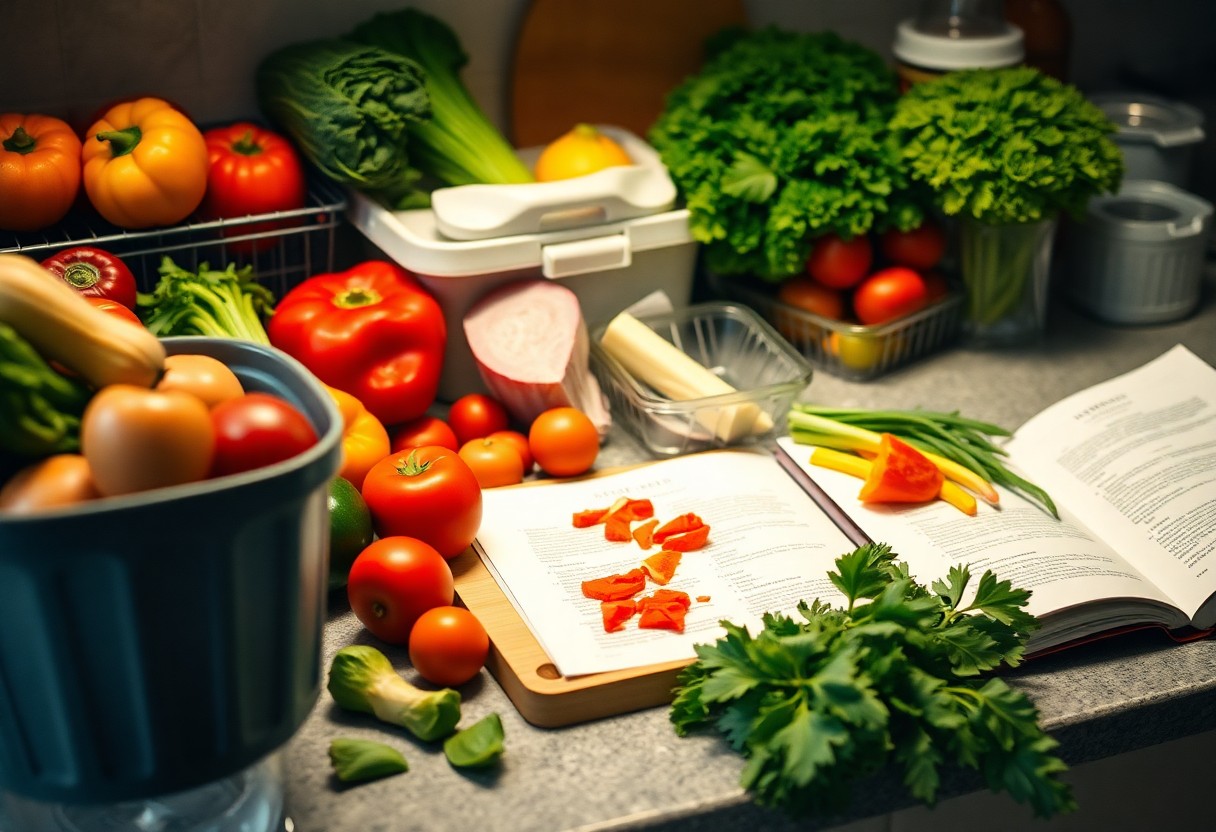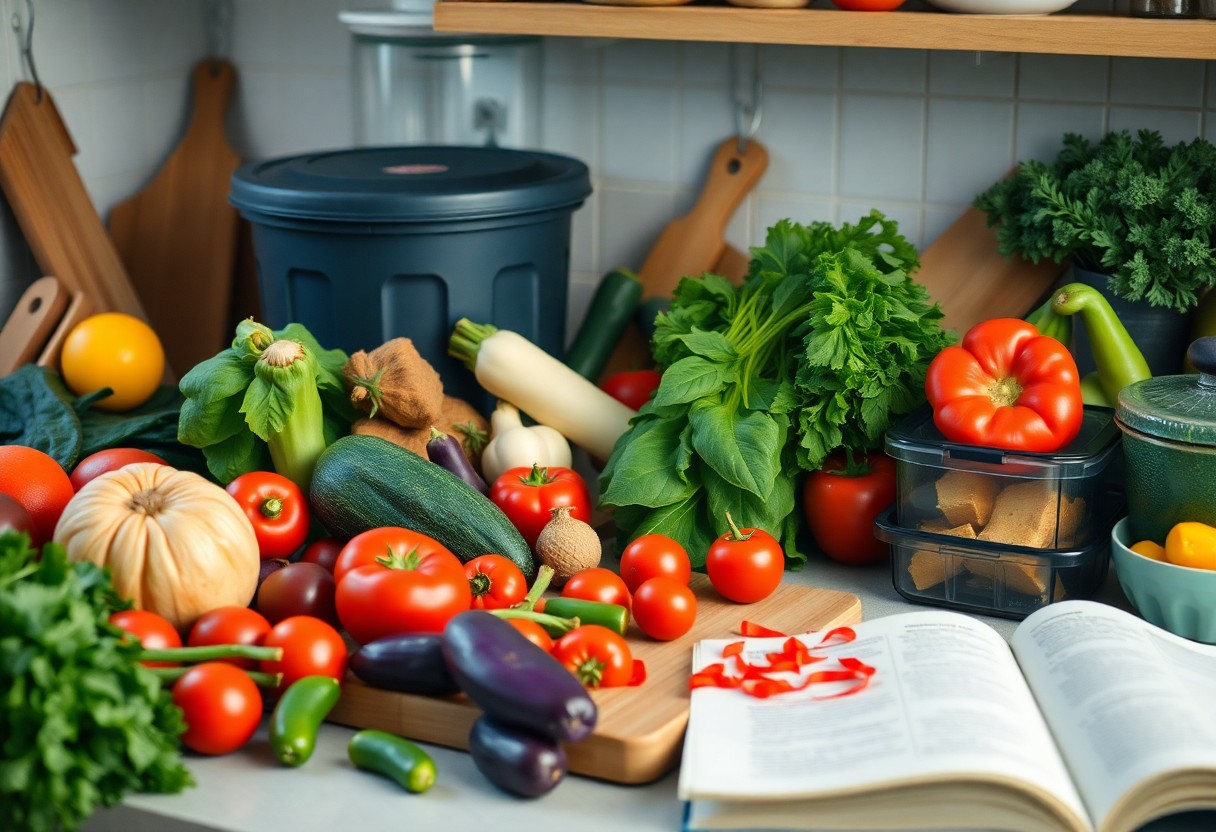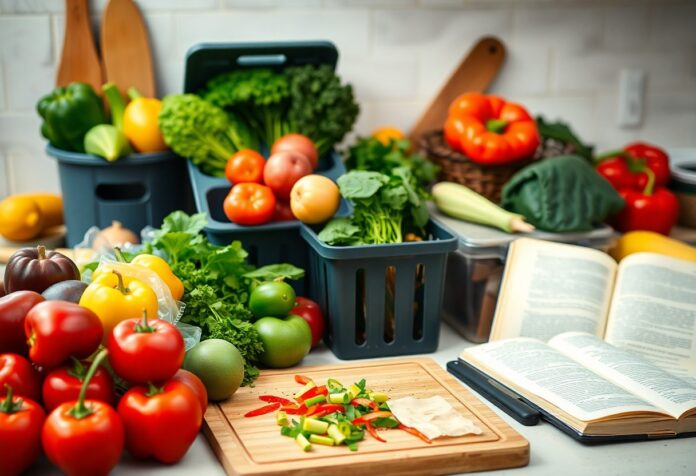Tips for reducing food waste not only benefit your wallet but also support a more sustainable lifestyle. By adopting simple cooking strategies, you can maximize the use of each ingredient and minimize leftovers. Understanding how to store your food properly, utilizing every part of your ingredients, and planning your meals effectively are important steps towards waste reduction. Embrace these smart cooking tips, and you’ll take meaningful action in your kitchen while enjoying delicious meals!

Understanding Food Waste
While food waste is a significant issue that extends beyond the confines of your kitchen, it begins at home. Understanding the sources and reasons behind food waste can empower you to make informed decisions that contribute to minimizing it. This involves acknowledging that food waste typically occurs at various stages of your food preparation and consumption process, from purchasing too much to improper storage and disposal of leftovers. By recognizing the patterns of waste in your household, you can tailor your food management to reduce excess waste effectively.
Common Sources of Food Waste at Home
Home kitchens often become a breeding ground for food waste due to several factors. One common source is overbuying ingredients, which can lead to spoilage before you have the chance to use them. Additionally, inadequate meal planning can result in leftover ingredients that you forget about, or leftovers themselves that are tossed away because they were not properly stored or consumed in time. Another significant contributor is the tendency to dispose of food that appears less-than-perfect, leading to an avoidable loss of perfectly edible items.
Environmental and Economic Impact
Among the many repercussions of food waste, the environmental and economic impacts are particularly concerning. When you waste food, it doesn’t just disappear; it contributes to greenhouse gas emissions in landfills, which aggravates climate change. Additionally, the resources that went into producing, packaging, and transporting that food, such as water, energy, and labor, are also wasted. Economically, this translates to a loss of money, as you spend on food that you ultimately do not consume, putting a strain on your budget.
But it’s not just, the environment that suffers; the financial implications are significant too. You may find that almost 30-40% of the food supply is wasted, translating to a staggering financial loss that could otherwise have been used to support your household or saved for future expenses. By adopting practices that reduce waste, you can not only foster a more sustainable living environment but also retain those funds for other important needs. Ultimately, careful management of food waste allows you to enjoy your meals while also aligning your lifestyle with social and environmental responsibility.
Planning and Shopping Strategies
Assuming you want to minimize food waste at home, developing effective planning and shopping strategies is key. By taking the time to plan your meals and make a well-informed grocery list, you can avoid impulse buys that often lead to items being forgotten in the back of your fridge. Consider setting aside a regular time each week to reflect on your meals, check your pantry for what you currently have, and make a list that focuses on the ingredients necessary for those meals. This not only helps you stick to your budget but also ensures you only purchase items you genuinely need, which will ultimately reduce the chances of them going to waste.
Creating a Smart Grocery List
Before you head out to the store, it’s important to create a smart grocery list. Organize your list by categorizing items based on where they are located in the store—such as produce, dairy, and pantry staples. This saves you time during shopping and helps prevent distraction-filled trips that can lead to extra purchases. Stick to your list to keep impulse buys at bay; you may find that simply having a plan makes grocery shopping a more streamlined and efficient experience.
Understanding Expiration Dates
For many consumers, expiration dates can be confusing, leading to unnecessary food waste. It’s important to know that “sell by,” “best by,” and “use by” dates represent different guidelines. “Sell by” dates are intended for retailers to manage inventory, while “best by” dates suggest when the product is at its peak quality, and “use by” dates indicate the last date for optimal safety and freshness. By understanding these terms, you can feel more confident in using food items that are still safe to consume past their dates.
At the same time, it’s important to practice visual and sensory checks on food items. Just because something is past its “best by” date does not mean it’s unsafe; many products can still be perfectly edible. Utilize your senses—look for changes in color, smell, or texture—as these can be more reliable indicators of food freshness than the calendar alone. Being savvy about expiration dates can help you use up what you already have, preventing unnecessary spoilage and enhancing your overall meal planning efficiency.
Meal Preparation Techniques
Now that you’ve decided to be more conscious about reducing food waste in your home, it’s time to explore effective meal preparation techniques. By implementing these strategies, you can not only save time during the week but also minimize the chances of food spoiling before you have a chance to use it. The key is to plan ahead, making sure that the meals you prepare align with what you already have in your pantry, fridge, and freezer. This way, you’re not just cooking for the sake of cooking; you’re maximizing your ingredients and utilizing each item to its full potential.
Batch Cooking and Meal Prepping
Around busy schedules, batch cooking and meal prepping can transform the way you approach your weekly meals. This method allows you to cook in large quantities, which means you can prepare several servings of the same dish in one go. Not only does this save you time, but it also reduces the likelihood of food spoiling, as you rapidly consume fresh meals made at once. When you batch cook, consider portioning out meals into reusable containers that make it easy to grab and go, ensuring that your meals are not only functional but also convenient.
Utilizing Leftovers Creatively
By thinking outside the box, you can turn leftovers into exciting new dishes rather than just reheating them the next day. This approach allows you to breathe new life into what might otherwise be forgotten food items in your fridge. For example, roast chicken from one night can easily become a flavorful chicken salad or a rich pasta sauce the next. You can also incorporate leftover vegetables into stir-fries, soups, or breakfast omelets, maximizing your resources and keeping your meals diverse and appealing.
Plus, being innovative with your leftovers not only enhances the taste but also minimizes the amount of food that ends up in the trash. By utilizing ingredients that may seem insignificant, like herbs, vegetables, or proteins, you can create new, flavorful dishes. Experimentation is key, allowing you to discover unique combinations! Also, turning stale bread into croutons or breadcrumbs can save those items from becoming waste. This creative approach to leftovers not only keeps your meals interesting but plays a significant role in cutting down on your food waste at home.
Proper Food Storage
Many homes struggle with food waste due to improper storage practices. Understanding how to store your food effectively can significantly prolong its freshness and quality, allowing you to reduce waste. Start by organizing your pantry and refrigerator; use airtight containers for dry goods, and label items to keep track of expiration dates. Incorporating the principle of FIFO—first in, first out—ensures that older items are consumed before newly purchased ones, further minimizing waste.
Best Practices for Refrigeration
Behind every successful effort to reduce food waste is a solid approach to refrigeration. Keep your refrigerator temperature set between 32°F and 40°F (0°C to 4°C) to maximize the shelf life of your perishable items. Avoid overpacking your fridge, as this can restrict airflow and lead to uneven cooling. Place food items in proper zones: store raw meat on the bottom shelf to avoid cross-contamination, while dairy products and eggs should be kept in the main body of the refrigerator for optimal freshness.
Tips for Freezing Foods Efficiently
Behind the art of freezing foods efficiently lies an effective strategy that can extend the life of your groceries. When freezing, always use high-quality freezer bags or airtight containers to prevent freezer burn. Consider portioning meals and ingredients to minimize waste, ensuring you only defrost what you need. Label everything with the date and contents, and try to minimize air in the packaging for best results.
- Use approved freezer bags or containers.
- Portion out meals or ingredients to avoid excess thawing.
- Label with dates and contents for easy organization.
Further, you can freeze certain foods that you might typically overlook, such as bread, herbs, and leftover sauces. By spreading out food consumption and storing these items using methods like ice cube trays for pureed herbs or sauces, you will optimize storage space and retain flavors. Knowing your freezer’s capacity and how to utilize it effectively will allow you to be more resourceful and reduce food waste significantly.
- Freeze leftover sauces and pureed herbs for later use.
- Use ice cube trays to portion small amounts of liquids.
- Be mindful of freezer space to avoid overcrowding.
Innovative Cooking Methods
Once again, you can embrace innovative cooking methods to help minimize food waste in your home. By thinking outside the conventional cooking box, you can find creative solutions that allow you to make the most out of every ingredient you have on hand. Techniques such as batch cooking or one-pot meals not only save time in the kitchen but also ensure that you efficiently utilize all your ingredients, reducing the likelihood of leftovers that may go to waste. Additionally, experimenting with sous-vide or steaming could help preserve the nutrients in your food while also making it more delicious, leaving less room for spoilage.
Using Vegetable Scraps
Vegetable scraps are often overlooked, but they can be a fantastic resource for your cooking endeavors. You might find it beneficial to collect vegetable peels, stems, and even wilting greens instead of tossing them in the trash. These scraps can be repurposed to make comforting stocks, adding rich flavors to your dishes without any additional cost. For example, you can simmer onion skins, carrot tops, and celery leaves together in water to create a nourishing broth that serves as the perfect base for soups and sauces.
Repurposing Unused Ingredients
The key to reducing waste in your kitchen is to be mindful of unused ingredients that may languish in the back of your pantry or refrigerator. Instead of purchasing new items for your meals, consider how you can combine what you already have. Creativity is your ally here; you could make a hearty vegetable casserole with leftovers or turn stale bread into delicious croutons or a bread pudding. This not only saves money but also allows you to create meals that might surprise you with their delightful flavors.
In addition, take the opportunity to organize your pantry and fridge regularly. By knowing what you have on hand, you can plan your meals around ingredients that are nearing their expiration date. This simple act can significantly reduce waste and allow you to enjoy a variety of dishes. By maximizing the potential of your unused items, you can contribute positively to both your culinary skills and the environment, ensuring that less food ends up in the landfill.

Educating Family and Friends
Unlike many common household challenges, educating your family and friends about reducing food waste can be a rewarding and impactful endeavor. By sharing information and engaging in discussions about the importance of minimizing waste, you can inspire those around you to adopt smart cooking habits. You can lead by example, showing how small changes in planning and preparing meals can significantly affect your collective carbon footprint and contribute to a more sustainable lifestyle. Encourage conversation regarding food storage, the use of leftovers, and creative recipe ideas to spark their interest and motivate them to participate.
Sharing Knowledge on Reducing Waste
Across various communities, knowledge about food waste reduction can foster a sense of collective responsibility. You can share tips on how to properly store fruits and vegetables, utilize seasonal produce, and embrace “no-waste” cooking techniques. An informative approach, coupled with real-life experiences, can make these concepts more relatable for your friends and family. By discussing the environmental and financial benefits associated with reducing waste, you create a compelling narrative that resonates with their values, encouraging a wider adoption of these practices.
Engaging in Community Initiatives
On a broader scale, engaging in community initiatives can amplify your efforts to reduce food waste. You can participate in local food drives, community gardens, or educational workshops focused on sustainability and waste reduction. By collaborating with your community, you not only expand your network but also contribute to a larger movement addressing food waste challenges. These initiatives often provide valuable resources and knowledge that can help you refine your own practices at home.
Consequently, participating in these community initiatives opens up opportunities for you to connect with like-minded individuals who are also passionate about minimizing waste. Joining forces with local organizations dedicated to food redistribution or food preservation can expose you to unique approaches and solutions while reinforcing the idea that reducing waste is a shared responsibility. Engaging with neighbors and organizations fosters a supportive network that encourages accountability and collaboration, ultimately leading to more significant changes at both the personal and community level.
Summing up
With these considerations, you can significantly decrease food waste in your home, turning your kitchen into a more sustainable space. By incorporating smart cooking tips such as meal prepping, understanding ingredient shelf life, and repurposing leftovers, you not only reduce waste but also save time and money. Paying attention to proper storage methods and planning meals can make a big difference in preserving the freshness of your food, which ultimately contributes to a more eco-friendly lifestyle.
Adopting these strategies not only benefits the environment but also fosters a greater appreciation for the resources you have. By being mindful of your cooking habits and making intentional choices, you empower yourself to make a positive impact while enjoying delicious meals. Every small step you take in minimizing food waste adds up, making your efforts worthwhile in the grand scheme of sustainability.


